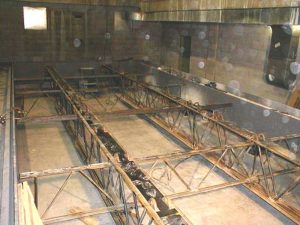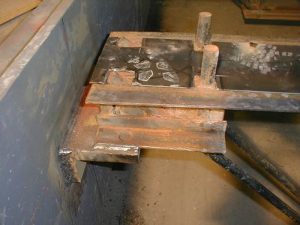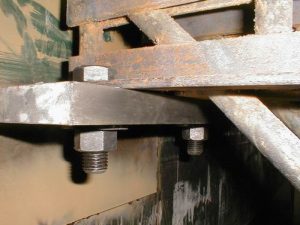Within the Context of New Industry Guidance
Most structural fire protection designs in the U.S. are conducted using prescriptive code requirements. This approach allows designers to select fire resistant assemblies from available listings that are qualified through standard furnace testing. Standard furnace testing exposes structural elements to a standard fire to determine a fire-resistance rating, typically expressed in hours. For certain listings, the designer must decide if the assembly is “restrained” or “unrestrained.” Indeed, architects routinely ask structural engineers to provide guidance on what classification should be assigned. This article reviews the history of this paradigm and provides considerations for designers tasked to classify restraint.
ASTM introduced “restrained” and “unrestrained” classifications into the ASTM E 119, Fire Test Standard, in the 1970s. This binary classification is primarily based on a series of furnace tests in which restrained steel beam and slab assemblies were able to sustain the applied loading longer (i.e., the assemblies do not experience runaway deflection) under heating, as compared to the corresponding unrestrained condition. In a standard furnace test, a composite floor beam and concrete slab assembly is considered “restrained” if both components horizontally bear directly against the edges of the furnace at the outset of the test; the assembly is considered “unrestrained” if the ends of the beam and slab can thermally expand without contacting the furnace edge. Many listings in the UL Fire Resistance Directory permit reduced fire protection thicknesses to achieve fire resistance ratings if the designer can demonstrate that the assembly will be “restrained” when it is constructed as part of an actual structural system.
Restraint Conditions
Many factors may affect the resulting restraint conditions of specific structural components during a fire, and these factors may actually enhance or decrease the resulting structural performance. For instance, a floor beam within a structural system may undergo thermal expansion under heating, which may impose lateral loads on the girder and column support points. Depending on the characteristics of the support points, the thermal expansion may be resisted or the thermally-induced lateral loads may exceed either the beam or support capacity. Unlike furnace testing, the support points may also need to resist subsequent thermal contraction during cooling.
The UL Directory, the American Institute of Steel Construction’s (AISC) ANSI/AISC 360-16 Appendix 4, and other publications provide guidance on determining thermal restraint conditions. However, it is the authors’ opinion that the current paradigm requires judgment from the designer. Since standard furnace testing for fire resistance does not consider structural system response, this judgment may be inconsistent among designers. In a composite floor beam and concrete slab assembly, both components would be restrained equally by the furnace framing during a “restrained” furnace test. In actual building construction, however, the beam and slab may experience varying degrees of restraint. This can result in differential longitudinal movement under fire exposure, particularly if the structural components are not acting compositely.
Several organizations have conducted furnace tests to address the ASTM E 119 restraint conditions. AISC and AISI funded furnace testing of steel floor assemblies, which demonstrated that restraint from the furnace frame provided no fire resistance benefit in the specific cases tested. This testing resulted in modifications to a specific UL listing (D982). NIST performed furnace testing of steel trusses (Figures 1a, b, and c) and found that an unrestrained assembly achieved a higher fire resistance rating when compared to an equivalent restrained assembly. These test results demonstrate that the effect of restraint varies among different structural systems and restraint conditions, and cannot be easily simplified in practice, especially in a binary fashion.
New Industry Guidance
The 2016 edition of ASCE/SEI 7 has a new Chapter 1 section on Fire Resistance. This section addresses structural fire protection by specifying the prescriptive approach as the default option for structural fire protection design. As an alternative, Chapter 1 permits use of structural fire engineering in accordance with the standard’s newly added Appendix E (Performance-based Design Procedures for Fire Effects on Structures). To compliment Appendix E, the ASCE/SEI Fire Protection Committee has also developed a new manual of practice on structural fire engineering, which is approved and scheduled for release this October.
When structural fire engineering is employed, analysis of structural system response inherently considers the amount of structural restraint that is actually present within a particular building design. However, when the prescriptive approach is used, the degree of restraint may be difficult for a designer to judge with a high level of confidence. In light of this, designers may choose to take a conservative approach when classifying restraint conditions per ASTM E 119. Notably, the International Building Code (IBC), Section C703.2.3, states that in-place conditions should be considered unrestrained unless structural documentation is provided that demonstrates a restrained condition in actual construction. In all cases, the authority having jurisdiction may be consulted as to the proper interpretation for a given project.
Summary
Clearly, there is a conflict between the boundary conditions and general limitations of standard furnace testing to represent realistic mechanical behavior, and the understanding of how structural systems actually perform under fire exposure. ASCE/SEI 7-16 and the upcoming manual of practice highlight this conflict, for they both prohibit designers from intermingling aspects of the prescriptive method with structural fire engineering. Accordingly, the current paradigm’s reliance on a designer’s judgment is highly problematic. Similar to most other aspects of the prescriptive approach, an industry-consensus prescription on the matter within the IBC and/or the ASTM E119 standard would relieve designers of an unrealistic obligation.
Acknowledgment: The authors would like to thank Dr. Jose Torero (University of Maryland) for his added insight/support.▪
References
ASTM E 119: Standard Test Methods for Fire Tests of Building Construction and Materials, ASTM International, Washington, D.C., 1971
R.W. Bletzacker, Fire Resistance of Protected Steel Beam Floor and Roof Assemblies as Affected by Structural Restraint, Symposium on Fire Test Methods–Restraint & Smoke, ASTM STP 422, American Society of Testing and Materials, Washington, D.C., 1967
UL Fire Resistance Directory, Underwriters Laboratories, Northbrook, IL, 2015
American Institute of Steel Construction (AISC), ANSI/AISC 360-16, Appendix 4, Chicago, IL 2016
C.J. Carter, F. Alfawakhiri, “Restrained or Unrestrained?” Modern Steel Construction, Chicago, IL, September 2013
Carter, C.J. and F. Alfawakhiri, “Comprehensive Coverage,” Modern Steel Construction, Chicago, IL, January 2017
Gross, J, et al., NIST NCSTAR 1-6B: Fire Resistance Tests of Floor Truss Systems, Federal Building and Fire Safety Investigation of the World Trade Center Disaster, National Institute of Standards and Technology, Gaithersburg, MD, 2005
ASCE/SEI 7: Minimum Design Loads and Associated Criteria for Buildings and Other Structures, American Society of Civil Engineers: Structural Engineering Institute, Reston, VA, 2016
Post, N. “Guidance for Structural Fire Engineering Making Its Debut,” Engineering News Record, New York, NY, February 2017
Post, N. “Fanning the Flames for Structural Fire Engineering,” Engineering News Record, New York, NY, January 2018
International Building Code (IBC), International Code Council, Washington, D.C., 2015



